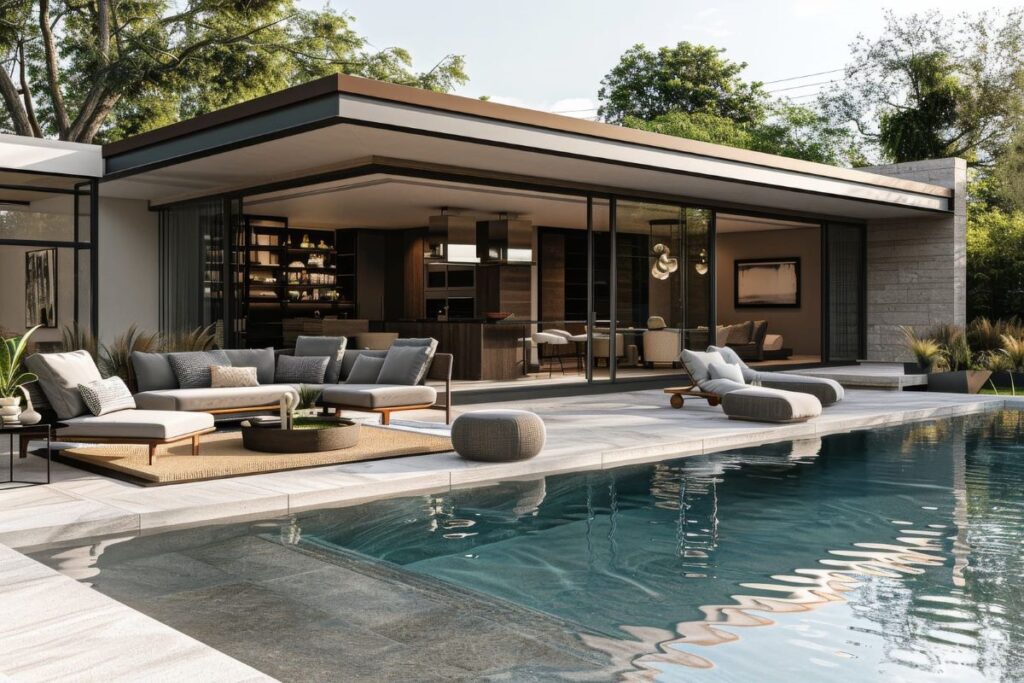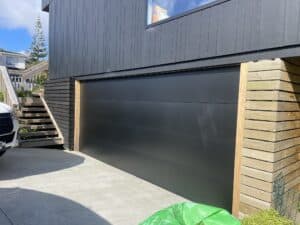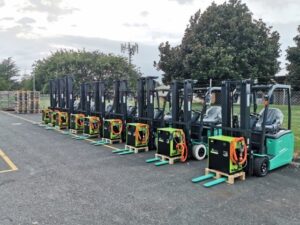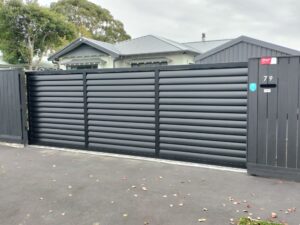When it comes to choosing a pool for your Auckland backyard, selecting the right material is crucial for longevity, maintenance, and aesthetics. Given Auckland’s unique climate, which includes mild, wet winters and warm, humid summers, here’s an overview of the common type of pool materials used to help you make the right choice.
Fiberglass Pools
Fiberglass pools are pre-fabricated, which means they are manufactured in a factory as a single-piece shell and then transported to your home for installation. Once on-site, the pool is lowered into an excavated space using a crane or similar equipment. This construction method allows for a quicker and more efficient installation process than other pool types.
Fibreglass pools come in predefined shapes, sizes, and depths, which makes the selection process much more straightforward, but it limits the customisation options. Typically, the excavation and installation of the pool shell can be completed in just a few days, making fibreglass an appealing choice for homeowners seeking a fast turnaround.
In the construction process, the fibreglass material is coated with a smooth, non-porous gel layer, which is not only gentle on swimmers but also highly resistant to algae growth and staining. This gel finish helps keep the pool’s surface clean and reduces the need for frequent maintenance. Additionally, the slick surface enhances the pool’s durability and prevents water absorption, which is a common issue with other types of pools.
In terms of structural integrity, fibreglass pools are designed to flex slightly, which means they are less prone to cracking than more rigid materials like concrete. This flexibility can be an advantage in areas with minor ground movement or freezing and thawing cycles. However, this isn’t a major concern in Auckland’s milder climate. However, you do need to take into account that fibreglass pools have size and shape limitations, as the moulds used for manufacturing dictate their final form.
Pros:
- Quick Installation: Fiberglass pools are pre-fabricated, so installation can take just a few days.
- Low Maintenance: Their non-porous surface makes them resistant to algae and bacteria buildup.
- Smooth Finish: The gel coating on fibreglass is gentle on swimmers’ skin.
Cons:
- Limited Customisation: Since they are pre-made, designs are limited to the manufacturer’s selection.
- Size Restrictions: Large or irregularly shaped pools can be challenging with fibreglass.
- Repair Difficulties: While durable, any cracks or blisters in fibreglass can be tricky and costly to fix.
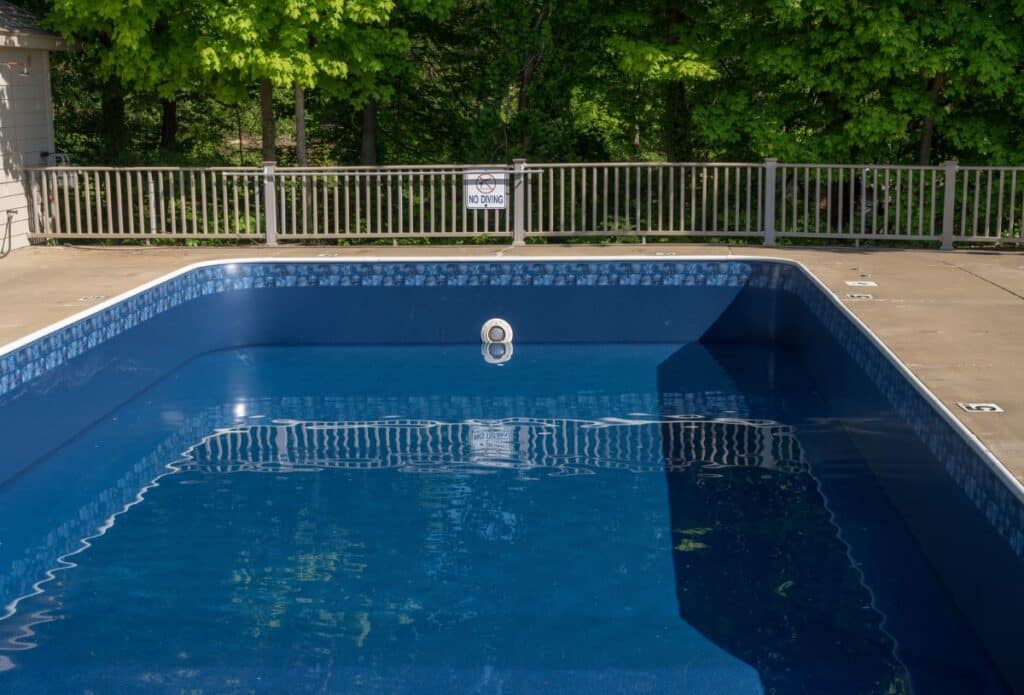
Vinyl Liner Pools
Vinyl liner pools are built using a steel or polymer frame that forms the pool’s structural walls. Once the framework is assembled, a vinyl liner is stretched over the frame and secured to create the pool’s waterproof interior. The walls are typically made from materials like galvanised steel, aluminium, or plastic polymers, which offer varying degrees of strength and durability.
The vinyl liner is a flexible PVC membrane that acts as the pool’s waterproof barrier. It is custom-fitted to the pool’s shape and available in a wide variety of colours, patterns, and textures, allowing for some degree of aesthetic customisation. The liner is soft to the touch, providing a smooth, comfortable surface for swimmers, making it an appealing option for families with children.
Vinyl liner pools are highly customisable in terms of shape and size, as the liners can be manufactured to fit almost any design. However, unlike concrete, intricate or unusual features such as ledges, steps, or benches must be built into the pool’s frame before applying the liner.
While vinyl liner pools are generally one of the more affordable in-ground pool options, they come with trade-offs. The liner is prone to tearing or puncturing, especially if sharp objects are introduced into the pool, such as pets’ claws or debris. Additionally, the liner will need to be replaced approximately every 7–10 years due to wear, UV exposure, and potential damage. This adds to the long-term maintenance costs of a vinyl pool.
Vinyl pools also require special attention to water chemistry, as improper pH levels can degrade the liner material over time. However, they are less prone to algae buildup than concrete pools, as the vinyl surface is non-porous, making it relatively easy to keep clean.
Despite the need for periodic liner replacement, vinyl pools remain popular due to their lower initial cost and the ability to achieve custom shapes.
Pros:
- Affordability: Vinyl pools are typically the most budget-friendly option.
- Custom Shapes: Vinyl liners can be made to fit a variety of shapes and sizes.
- Smooth Surface: The liner is soft and gentle for swimmers.
Cons:
- Liner Replacement: Vinyl liners typically last 7–10 years and can tear, requiring costly replacements.
- Durability Issues: The liner can be damaged by sharp objects or pets, leading to leaks.
- Temperature Sensitivity: Vinyl can become brittle in cooler weather, affecting its longevity.
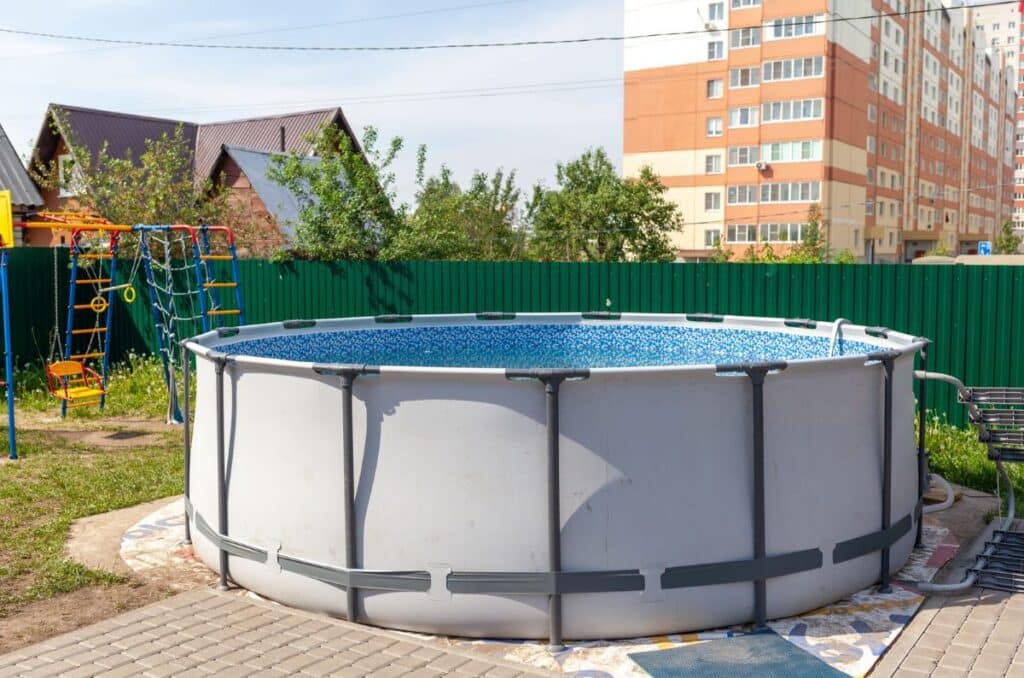
Above-Ground Pools
Above-ground pools are freestanding, portable structures designed to sit on top of the ground, offering homeowners a temporary and budget-friendly option. Typically made from materials such as steel, resin, or wood, they are supported by a frame that provides stability. These pools are pre-manufactured and come in set shapes, often round or oval, which limits customisation options compared to in-ground pools like concrete.
Steel frames are popular due to their strength, though they are prone to rust and corrosion over time, especially in Auckland’s humid climate. Resin frames offer more resistance to weathering, but both options lack the long-term durability of concrete. Wood-framed pools provide a more natural look, but the constant exposure to moisture means regular maintenance to prevent rot, unlike the solid, low-maintenance nature of a concrete pool.
Above-ground pools are typically assembled in a matter of days, which makes them a quick fix for those looking for immediate fun. However, the installation speed comes at a cost to durability and longevity. The structure is more vulnerable to damage from weather and active use, meaning frequent repairs may be necessary. Additionally, above-ground pools are more susceptible to aesthetic wear over time and often lack the visual appeal and integration that an in-ground concrete pool can offer.
Though above-ground pools are attractive for their lower initial cost, they offer limited customisation in terms of depth and shape. Most above-ground pools have a shallower depth, typically around 1.2 to 1.5 meters, restricting diving or more advanced swimming activities. For homeowners looking for a long-lasting, custom pool that fits their landscape perfectly, an above-ground pool may fall short of their vision.
In contrast, while concrete pools take longer to build and may have a higher upfront investment, they provide homeowners with a fully customised, long-term solution that blends seamlessly into their backyard. They also offer far more flexibility in design, depth, and features, ensuring a pool that can cater to both relaxation and recreation for years.
Ultimately, while an above-ground pool can provide immediate enjoyment, it doesn’t offer the same luxury, durability, or value as a concrete pool, which is a more robust investment for homeowners seeking a truly bespoke swimming experience.
Pros:
- Affordability: Above-ground pools are inexpensive and quick to install.
- Mobility: They can be dismantled or relocated if necessary.
Cons:
- Aesthetics: These pools are often less visually appealing and may not blend seamlessly with landscaping.
- Limited Durability: They typically have a shorter lifespan compared to in-ground pools.
- Shallow Depths: Above-ground pools generally offer shallower water, which limits diving or more advanced swimming.
Concrete Pools (The Best Choice)
Concrete pools are renowned for their unmatched flexibility and strength. Built on-site, they offer limitless options in terms of shape, size, and features. Let’s explore what makes concrete pools the ideal choice for Auckland backyards, diving deeper into their construction process, durability, and potential.
Construction Methods: Shotcrete and Gunite
Concrete pools are constructed using either shotcrete or gunite, both of which involve spraying concrete onto a rebar framework to form the pool’s shell. The main difference lies in how the concrete is mixed and applied:
- Shotcrete: This method uses premixed wet concrete sprayed through a high-pressure hose onto the surface. Shotcrete is preferred for its easier and faster application, often leading to a smoother finish.
- Gunite: Gunite is a dry mix that combines concrete and water at the nozzle during application. It allows more flexibility for custom shaping on-site, which is useful for complex pool designs.
Both methods are highly durable and create a robust and monolithic structure. Concrete’s versatility allows for various creative options, such as building curved walls, custom depths, tanning ledges, or beach entries. This makes concrete pools ideal for Auckland’s diverse landscapes, where some backyards may have sloping terrain or require innovative designs to optimise space.
Customisation
Concrete pools are the ultimate choice for those who want full creative control over their backyard oasis. Concrete allows for truly personalised designs, from infinity edges to sunken swim-up bars. Auckland homeowners often have unique requirements due to the city’s varied topography, making concrete’s ability to adapt to narrow or irregularly shaped plots invaluable. Whether you’re looking to build a small plunge pool or a sprawling resort-style pool with added features like waterfalls and fountains, concrete can accommodate it all.
Beyond just shape and size, the finish of a concrete pool can be customised to achieve a particular look and feel. Popular finishes include:
- Tiling: Tiles come in a range of materials like ceramic, glass, or natural stone, giving your pool a luxurious appearance.
- Pebble finishes: Pebblecrete or pebble finishes add a natural, textured look that blends well with the outdoors.
- Plaster: Available in various colours, plaster gives the pool a sleek, polished appearance.
Durability
Concrete pools are incredibly durable and can withstand Auckland’s sometimes unpredictable climate. The solid, reinforced concrete shell ensures that the pool remains stable even in areas with seismic activity, which can be a consideration in New Zealand.
What’s more, concrete pools are more resistant to damage from active use than fibreglass or vinyl pools. Whether children are playing, pets are splashing, or there is high traffic during summer gatherings, a concrete pool holds up exceptionally well to heavy use.
Aesthetic Versatility
One of the concrete pools’ greatest strengths is their ability to achieve almost any aesthetic. Homeowners can seamlessly integrate their pool into their backyard’s landscape design. Whether you’re aiming for a modern minimalist look with clean lines or a more natural lagoon-style pool with rock formations and waterfalls, concrete can bring your vision to life.
Added Features
Concrete pools excel at incorporating luxury features. Because of their strength and adaptability, concrete easily integrates high-end elements like infinity edges, waterfalls, spas, and swim-up bars into a pool’s design. Features like tanning ledges or submerged seating areas provide extra comfort and relaxation options.
For anyone looking to add energy-efficient options to their backyard oasis, concrete pools are able to accommodate built-in solar heating systems, LED lighting, and even automatic cleaning systems, which make the pool maintenance easier and more eco-friendly.
Cons of Concrete Pools
While concrete pools offer unparalleled benefits, they do come with a few things to consider.
Longer Installation Time
Building a concrete pool is a more involved process than pre-fabricated fibreglass pools. The construction of the pool’s framework, application of shotcrete or gunite, and curing can take several weeks to months, depending on the complexity of the design and weather conditions. The curing process alone can last for weeks, as the concrete must fully harden before any further work, like adding the finish, can be done.
Higher Initial Cost
Concrete pools require a significant investment upfront. The materials, labour, and customisation options contribute to the higher costs. However, given the long lifespan and added value a concrete pool can bring to a home, many Auckland homeowners consider it a worthwhile investment.
Maintenance
Concrete pools are porous, meaning they can harbour algae and bacteria if not maintained properly. Regular cleaning and periodic resurfacing are necessary to keep the pool in top condition. However, new advances in sealing and finishing materials are helping to reduce the porousness of concrete, making them easier to care for over time.
Why Concrete Pools Are Ideal for Auckland Backyards
Given Auckland’s varied terrain and climate, concrete pools offer durability and customisation, making them a standout option. Their ability to be built to any specification makes them ideal for sloping properties, irregular spaces, or homeowners who desire a unique feature that a standard pool can’t provide.
When it comes to pool installation, don’t forget to check out fencing options too, after all it’s important to keep, friends, family and pets safe.
What’s more, Auckland’s weather can fluctuate between sunny summers and damp winters, and a concrete pool can easily handle the elements, ensuring it remains in great shape for decades. Whether your focus is on luxury, customisation, or creating a family-friendly space, a concrete pool offers the best long-term investment for an Auckland backyard.

